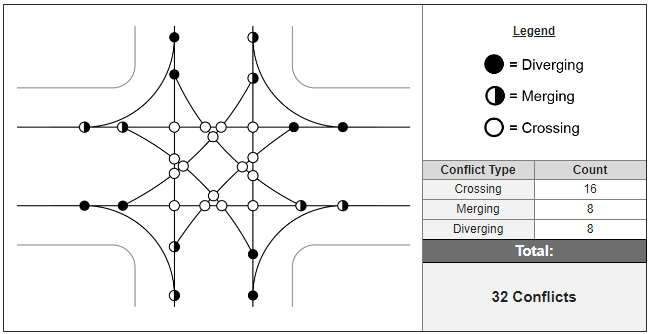Innovative Intersections and Interchanges
← Innovative intersections main page
An RCUT is also known as:
- Superstreet intersection
- J-turn intersection
- Reduced conflict intersection (RCI)
- Synchronized street intersection
What Is An RCUT?
 |
 |
- Intersection design where all side street movements begin with a right turn
- Side street left-turn and through vehicles turn right and make a U-turn at a dedicated downstream median opening to complete the desired movement
- Main intersection and median U-turns can be designed as signalized, stop controlled or yield controlled
When Should It Be Considered?
- On median-divided highways
- At intersections:
- With heavy through and / or left-turn traffic volumes on the major street
- With low through and left-turn traffic volumes on the side street
- With three or four legs
Benefits
- Improved safety: Reduces the number of points where vehicles cross paths and eliminates the potential for head-on crashes
- Increased efficiency: Each direction of the major street can operate independently, creating two one-way streets and increasing the overall intersection capacity
- Shorter wait times: Fewer traffic signal phases means less stopping for arterial vehicles and allowing only right turns from side street vehicles means less waiting
- Cost-effective: An RCUT can be more cost effective than adding lanes to improve capacity
How to Navigate
Below is how to navigate an RCUT. Click the image to view a larger version or watch the video.
Conflict Points
The number of conflict points (locations where vehicle travel paths intersect) is one metric that can be used to evaluate the safety of an innovative intersection or interchange.
There are three categories: crossing, merging or diverging.
In general, merging and diverging conflict points — where vehicles are moving in the same direction — are associated with less severe crash types than crossing conflict points where vehicles are moving in opposite directions.
The diagrams below compare the possible vehicle travel movements and associated conflict points at a conventional four-leg intersection to an RCUT.
These diagrams represent a general case, with one travel lane in each direction, and do not take into account pedestrian or bicycle movements at an intersection or interchange.
When compared to a conventional four-leg intersection, an RCUT has 14 fewer crossing conflict points.
Conventional Intersection: Conflict Points

RCUT: Conflict Points
Resources
From the Virginia Department of Transportation
From the Federal Highway Administration
Also
- Driving simulator study of J-turn acceleration / deceleration lane and U-turn spacing configurations (Missouri Department of Transportation, Midwest Transportation Center, United States Department of Transportation, December 2016):
This study evaluated the impacts of lane configuration, u-turn spacing, and signage on safety at RCUT intersections. - System-wide safety treatments and design guidance for J-turns (Missouri Department of Transportation, Midwest Transportation Center, United States Department of Transportation, December 2016):
This study examined the effectiveness of safety treatments at RCUT intersections and developed guidance on the spacing between the main intersection and U-turns and on the use of acceleration lanes.






